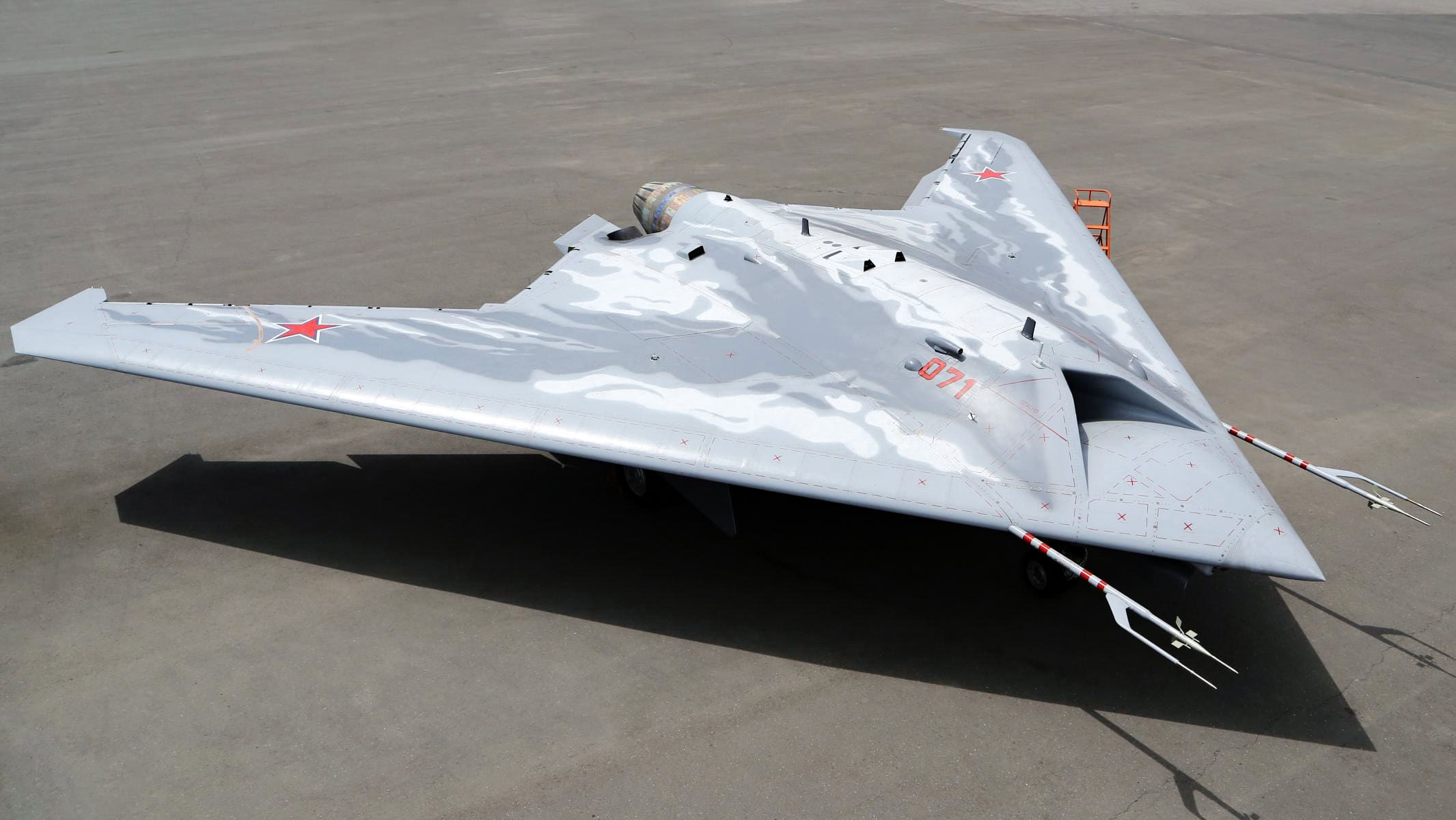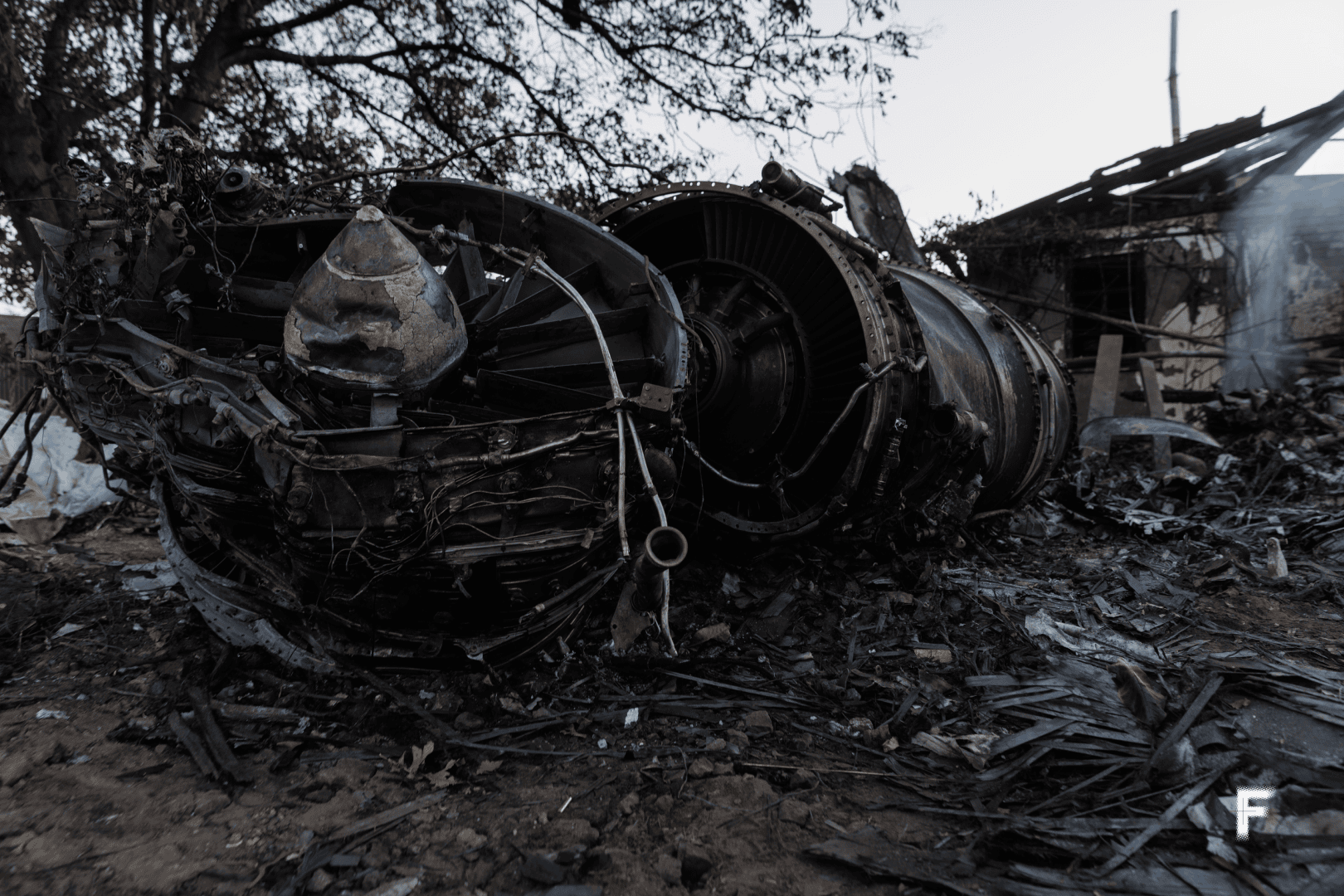

The downed Russian Sukhoi S-70 Okhotnik-B drone in Ukraine debunked its developers’ claims
Debris from a downed Russian drone, large enough to be mistaken for a fighter jet, fell on Kostyantynivka, Donetsk region, on October 5, 2024. Ukrainian forces reported that debris from the downed Russian Sukhoi S-70 Okhotnik-B drone was shot down by a Russian Su-57 aircraft during combat zone tests. The question emerged: What new threat appeared in Ukrainian skies, and what was it capable of? Could it carry weapons? If so, how much? Frontliner dived into Russian sources and revealed what the Sukhoi S-70 Okhotnik-B is.
The Sukhoi S-70 Okhotnik-B, or Hunter-B, is a 20-ton, tailless “flying wing” UAV. It measures 14 meters in length (roughly two and a half giraffes) and has a wingspan of over 19 meters (more than three giraffes).
In 2021, Russian engineers pledged to equip the Okhotnik-B with the powerful, afterburner-less AL-41F engine, designed for fifth-generation fighters. [1]. Regardless, the drone had a lower-class engine for 4-generation fighters – AL-31 (also used for the Su-27) [2]. Despite this, the 20-ton drone can reach speeds of 1,000 km/h, soar to altitudes of 10 kilometers, and endure 24-hour flights. According to the Russian defense ministry, the Okhotnik-B has an anti-radar coating, boasting with electro-optics, radars for intelligence and data gathering. If the Russians are to be believed, the stealth technology used during development should make their drone invisible on the battlefield.


History of creation and myths about the Okhotnik-B
The Novosibirsk Aircraft Production Association Plant took on the task of manufacturing three prototype Okhotnik-B drones for rigorous testing. Spearheading this ambitious project was Sergey Bibikov.
The Okhotnik-B was first mentioned publicly in 2009 at the Moscow Air Show. In July 2012, the Sukhoi company received a contract to develop a strike-reconnaissance drone, showing the final prototype seven years later, the prototype was shown.
Okhotnik-B made its first flight in August 2019. However, contrary to the 24-hour flight duration claimed in its technical specifications, the initial test flight lasted a mere 20 minutes.
In 2020, the Russian media claimed it was planned to create “swarms” of drones, operating autonomously or under the control of one Su-57 pilot [3]. However, the Russian military expert Viktor Murakhovskyi envisioned that the UAV should work in conjuction with three of these or even with 12.


As of 2024, only four Okhotnik-B drones had been produced, and the concept of networked drone swarms had been largely abandoned.
In 2020, Yuriy Slyusar, head of the United Aircraft Corporation, assured Vladimir Putin that the Russian Space Forces would receive deliveries of the Okhotnik-B drone starting in 2024. However, as of October 2024, this promise remains unfulfilled.
In 2021, the state-owned RIA Novosti reported that preparations were underway to produce three additional Okhotnik-B drones for testing in 2021-2022.[7]. The Russian Ministry of Defense urged the military-industrial complex to expedite the production of prototypes and initiate serial deliveries of the drone.[8]. In autumn, test pilot Yevgeny Frolov further fueled the hype, claiming that future Okhotnik-B drones would possess advanced autonomy, capable of returning to base even if communication with the pilot is lost.[9].
“Improvements” and “modifications”
In December 2021, a new modification of the Okhotnik-B featuring a flat jet nozzle was unveiled. Russian defense ministry official Aleksey Krivoruchko announced the integration of artificial intelligence into the drone, promising enhanced maneuverability and autonomous attack capabilities. [10]. Early in 2023, Rostec head Sergey Chemezov declared the commencement of serial production of the Okhotnik-B. In January 2024, Admiral Nikolai Yevmenov expressed the Russian Navy’s intention to acquire the UAV. [12].
Soon after, Russian expert Kirill Strelnikov, in an article titled “Russia Will Win the First War of Drones in History,” once again pushed back the timeline for the Okhotnik-B’s serial production, stating that it would only commence in the second half of 2024. [13].
Finally, in October of this year, the Okhotnik-B flew during tests in the combat zone. The drone lost control and was ultimately shot down by its own Su-57 pilot, crashing in the Ukrainian town of Kostyantynivka.


Can the declared AI-based intelligence cause loss of control over the Okhotnik-B as the first uprising of the machine, which decided to crash in Ukraine? Did the drone possess the intelligence of a giraffe? This is a matter for discussion and further observation, along with further shifts in deadlines for testing, modernization, and mass production.
Given the history of delays and setbacks, it seems unlikely that the Sukhotni S-70 Okhotnik-B will be a significant player in the near future. Perhaps a more traditional naming convention, such as “Orlan,” “Stork,” or “Stryzh,” might have brought better luck. As it stands, the Okhotnik-B appears to be more of a victim of technical challenges and unrealistic expectations than a formidable predator of the skies.
The profits generated from the Okhotnik-B project are likely funneled into the pockets of Russian officials, who use the funds to secure additional contracts for the drone’s “improvement.”
Once touted as a new threat to NATO, the drone turned out to be nothing more than another invention of Russian propaganda, assembled and embellished with claims of artificial intelligence and mass production. It seems that the Russian military and aircraft designers’ fears regarding the loss of the Okhotnik-B in Ukraine are not primarily driven by concerns over the Ukrainians gaining access to advanced Russian technology. Instead, the Russians are afraid of another exposure to the backwardness of their equipment, its inconsistency with the declared technical characteristics, and the primitiveness of the approach to its creation.
After all, the Sukhoi S-70 Okhotnik-B exposed the hubris of its creators.
Sources:
[1] https://ria.ru/20210212/okhotnik-1597135614.html
[2] https://www.forbes.com/sites/davidaxe/2024/10/05/a-rare-russian-stealth-drone-fell-to-the-ground-inside-ukrainian-territory-what-brought-down-the-okhotnik/
[3] https://ria.ru/20200705/1573855201.html
[4] https://ria.ru/20201202/bespilotnik-1587278036.html
[5] https://uacrussia.ru/ru/
[6] https://radiosputnik.ru/20200803/1575313773.html
[7] https://ria.ru/20210212/okhotnik-1597135614.html
[8] https://ria.ru/20210719/bespilotnik-1741785980.html
[9] https://radiosputnik.ru/20211003/bespilotnik-1752856191.html
[10] https://radiosputnik.ru/20211214/bpla-okhotnik-1763606570.html
[11] https://ria.ru/20220528/okhotnik-1791355512.html
[12] https://ria.ru/20240110/vmf-1920466889.html
[13] https://ria.ru/20240212/drony-1926718432.html
Text: Nazar Zvirynskyi ; Photo: Patrick Enssle
